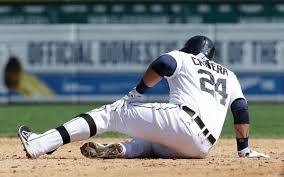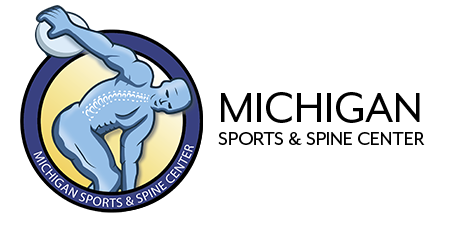Tight Hamstring Affects Miguel Cabrera – How to Prevent Them

Recently, a tight hamstring forced an early exit for Detroit Tiger’s first baseman, Miguel Cabrera, during a game against the Red Sox at Comerica Park. It’s been reported that Cabrera had been complaining about his left hamstring bothering him for a few days prior to that Sunday night’s game.
The hamstring muscles are a group of large, powerful muscles that span the back of the thigh, from the lower pelvis to the back of the shin bone. The hamstring is the important muscle that functions to extend the hip joint and bend the knee joint.
ATC, Julie Parker, of Michigan Sport and Spine, explains how to prevent tight hamstrings from forming, and also how to care for them once they have occurred:
“Before exercising, or engaging in any type of rigorous activity; stretching properly is key!” said Parker.
The hamstring is used in various sporting activities, as well as normal, everyday life. Certain sports that commonly cause a hamstring injury typically involve sudden accelerations, such as sprinting. Other sports where a hamstring injury may occur include track and field, baseball, soccer, and basketball.
One of the primary reasons we work out is to release and relieve the body from stress, all the while improving our strength and agility. If the muscles are in synchronicity, a quality workout session should centralize the body.
However, if an essential element of the musculo-skeletal system; for example, your hamstrings, are tight or overactive, then your normal workout session can be anywhere from painfully challenging to downright damaging to your body.
Parker comments, “You have to warm up your body really good in order to abstain from injury. Staying hydrating can also help with preventing injury and muscle strains”.
Head of soccer operations and sports fitness professional, Enes Sunje, of Michigan Sports and Spine’s gym, CORE discusses how he incorporates a beneficial stretching technique with his clients for hamstring flexibility.
“Training, stretching, and flexibility are crucial when it comes to hamstrings,” said Sunje.
“I use PNF stretching (Proprioceptive neuromuscular facilitation stretching) a lot on clients,” he said, “It increases their range of motion.”
PNF is an advanced form of flexibility training that involves both the stretching and contraction of the muscle group being targeted.
“PNF involves me working hands on with the client,” Sunje said, “In applying PNF, I stabilize specific parts of the patient’s body with one hand on the body, while the other hand is used to grip the extremity or relevant part of the limb of the patient to offer highly specific patterns of resistance,” he states.
Sunje concludes: “PNF exercises will dramatically improve your flexibility, as well as increase your range of motion.”
“Once your hamstrings are limber and the resulting pressure and stress is relieved from the lumbar region, then the entire workout experience as a whole will intensify, thus increasing the body’s strength and range of motion, as a result,” he stated.
If you have any questions or would like to schedule a training session with one of the CORE Sports Fitness trainers, contact information is below.
If you have any questions or would like to schedule a training session with one of the CORE Sports Fitness trainers, contact information is below.
If you are dealing with any type of sports injury, Michigan Sports and Spine Center can get you back in the game. With locations in Clinton Twp., Livonia, and Southfield Dr. Jeff S. Pierce, a sports medicine specialist, and his staff focus on a comprehensive evaluation, proper diagnosis and individualized treatment regimens. With patients ranging from high-profile athletes to everyday people, we are confident that we can not only relieve, but also resolve your pain.
Acute Injuries:
- bruises/contusions
- puncture wounds/cuts
- ligament injuries
- injuries to tendons
- strains
- fractures
- bone dislocation
Overuse injuries:
- Achilles tendonitis/tendinosis – the breakdown of soft tissues around and in the Achilles tendon that connects the calf muscles to the heel bone.
- Stress fracture – a hairline crack in the bone.
- Retrocalcaneal bursitis – inflammation of the bursa, which causes rawness, sensitivity and swelling of the back of the heel and the ankle.
- Plantar fasciitis – inflammation of the thick tissue on the bottom of the foot, which in turn causes pain when walking.
- Metatarsalgia – an ache in the front (ball) of the foot.

TREATMENT:
There are several treatment options for foot and ankle pain. Be sure to contact Michigan Sports & Spine Center or another specialist in order to receive the proper diagnosis and receive the proper treatment plan.
Physical Therapy/Exercise Training:
- The combination of exercise training and physical therapy commonly includes stretching, strengthening and low-impact aerobic exercises.
- A physical therapist can design a regimen that helps to reduce pain and discomfort and strengthen the muscles that affect your ankles, therefore getting you back on track.
Injections:
- Trigger point injections – a procedure used to treat painful areas of the muscle that contain trigger points, or knots of the muscle that develop when muscles do not relax. Involves the injection of medication directly into the trigger point.
- Facet injections – entails injecting a small amount of local anesthetic and/or steroid medication, which anesthetizes the facet joints and blocks pain.
Weight Loss and Exercise:
- Losing extra weight can also help to lose the pain, and increase your comfort level and your quality of life.
- Exercise can aid in achieving your weight loss goals, and at the same time strengthen your muscles and decrease pain.
Massage Therapy:
- A deep massage will decrease muscle spasms, fight inflammation and encourage relaxation.
Osteopathic Manual Medicine/Manipulations:
- Relieves pain by reducing pressure on sensitive structures, increasing flexibility, improving blood flow and decreasing muscle tension.
Acupuncture:
- Based on the principles of traditional Chinese medicine, acupuncture involves sticking very thin needles into specific energy points within the muscle/skin in an effort to diminish inflammation, pain and discomfort.
- Acupuncture is successful because it helps to release endorphins and serotonin, which act to reduce pain.
RICE:
- Rest your ankle or foot. Don’t walk or put weight on it.
- Ice your ankle or foot with an ice pack for 20-30 minutes, several times a day.
- Compress and support your foot or ankle with bandages or ace-wraps.
- Elevate you foot or ankle for 48 hours. Keep your ankle/foot propped up on pillows about your heart level.
Sources: WebMD
ABOUT MICHIGAN SPORTS & SPINE CENTER:
We’re innovative leaders utilizing cutting-edge technologies such as musculoskeletal ultrasounds, PRP, stem cell treatment, and other innovative procedures. Michigan Sports & Spine Center is committed to resolving your pain, not simply masking it. We treat the whole body, not just the injury, and perform preventative treatment so your injury doesn’t come back. Our studies prove that Michigan Sports & Spine Center has patient success rates much higher than the national average. We treat everyone from high-profile athletes to your neighbor next door. Our primary focus is getting our patients back into the game of life!
